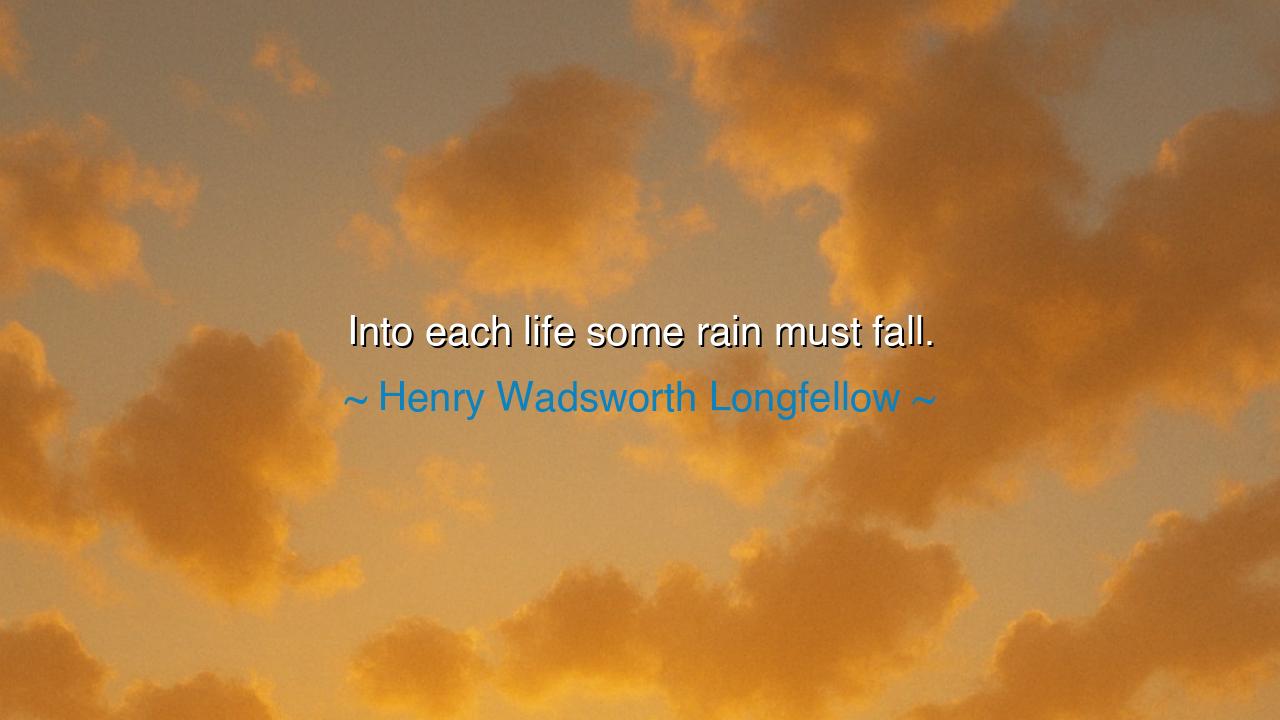
Into each life some rain must fall.






In the gentle wisdom of his pen, Henry Wadsworth Longfellow, the poet of the American heart, wrote the immortal words: “Into each life some rain must fall.” These few syllables, tender and timeless, carry within them the whole philosophy of endurance. They speak to the universal truth that sorrow, like rain, visits every soul — that no life, however radiant, escapes the shadow of grief. Yet, Longfellow does not write in despair. His words are not the cry of bitterness, but the song of acceptance — the recognition that even the rain nourishes the earth, and that pain, too, has its purpose in the growth of the soul.
The origin of this line lies in Longfellow’s poem “The Rainy Day,” written in 1842, after a time of deep personal loss. His beloved wife had died, leaving him to raise his children alone. In that season of sorrow, he turned to nature, as poets often do, to seek meaning in its cycles. He saw that rain, though it darkened the sky, was not punishment but renewal. The earth drank from it and blossomed again. From this revelation was born the line that has comforted countless hearts: that suffering is not the enemy of life, but its teacher. Thus, what begins as lament becomes a hymn of hope, echoing through generations as a reminder that all storms, no matter how fierce, are followed by light.
To understand the depth of his message, one may think of Abraham Lincoln, who lived in an age heavy with its own storms. Burdened by civil war, by death, and by the loneliness of leadership, Lincoln carried grief like a cloak upon his shoulders. Yet he endured with quiet faith, believing that sorrow itself could shape wisdom and compassion. When he said, “I have been driven many times upon my knees by the overwhelming conviction that I had nowhere else to go,” he spoke the same truth that Longfellow knew — that rain refines the spirit, humbling the proud and softening the hard of heart.
For rain, in the ancient tongue of poets, is the symbol of trial and of cleansing. It falls upon all — the righteous and the unjust, the joyful and the broken. No one is spared its touch. Yet, as the earth would perish without it, so too would the human soul grow barren without adversity. The easy days make us content, but it is the storm that makes us strong. The ancients understood this. The Greeks told of heroes tested by fate; the scriptures spoke of deserts that must be crossed before reaching the promised land. Longfellow’s words are a continuation of this eternal wisdom — a reminder that sorrow is the rain by which the garden of the soul grows.
But hear this, my children: the rain does not last forever. The same poem that gives us this famous line ends with hope — “Behind the clouds is the sun still shining.” Longfellow teaches us that patience is the virtue of the wise. When hardship falls, we must not curse the heavens, but wait for the clearing. For just as every tempest runs its course, so too do grief and difficulty pass. And when they do, they leave behind the fragrance of renewal, the freshness of gratitude, and the quiet beauty of resilience.
The lesson, then, is both simple and profound. When the rains of life come — when loss strikes, when failure humbles, when dreams crumble — do not despair. Do not believe you have been singled out for sorrow. Rather, know that you walk the same path as all who have lived and loved before you. Let your tears fall, for they are the cleansing waters of the heart. Then lift your gaze to the horizon, for beyond the storm lies the sunlight of new beginnings.
Take this teaching into your days: welcome both the sunshine and the rain. When joy visits, cherish it deeply. When sorrow comes, bear it bravely, for both are gifts from the same sky. Each drop of rain that falls upon your life is shaping you, softening you, teaching you the compassion that can only be born through suffering. In the end, you will see — as Longfellow saw through his tears — that the rain was not your undoing, but your awakening.
For indeed, into each life some rain must fall, but it is that very rain which teaches the soul to bloom again — brighter, humbler, and more alive than before.






AAdministratorAdministrator
Welcome, honored guests. Please leave a comment, we will respond soon